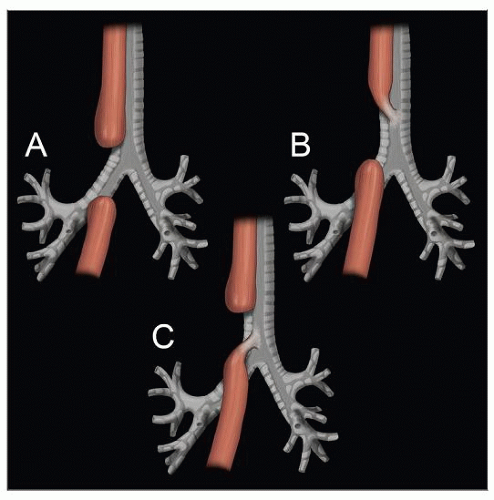Tracheoesophageal Fistula
Alexandros D. Polydorides, MD, PhD
Key Facts
Terminology
TEF: Congenital fistulous communication between trachea and proximal &/or distal esophagus
EA: Complete interruption of lumen continuity
Clinical Issues
0.02-0.04%, usually with coexistent EA
Most common esophageal congenital malformation
Associated congenital malformations in 50%
Image Findings
Passed nasogastric tube stops at 10-12 cm if EA
Macroscopic Features
Type C (3B): Proximal EA with distal TEF (85-90%)
Microscopic Pathology
Epithelium-lined connection between respiratory and digestive tubes, irregular smooth muscle, scar
Tracheobronchial elements in distal esophagus
 Graphic shows gross classification: A) esophageal atresia only, B) esophageal atresia and proximal tracheoesophageal fistula, C) proximal esophageal atresia and distal tracheoesophageal fistula. |
TERMINOLOGY
Abbreviations
Tracheoesophageal fistula (TEF)
Esophageal atresia (EA)
Vertebral, anal, cardiac, tracheoesophageal, renal, and limb (VACTERL) association
Definitions
TEF: Congenital fistulous communication between trachea and proximal &/or distal esophagus
EA: Complete interruption of lumen continuity
ETIOLOGY/PATHOGENESIS
Developmental Anomaly
Incomplete separation of primitive foregut
Abnormal proliferation of tracheoesophageal septum
Genes Implicated
RAR, SHH, and others
Acquired TEF
Malignancy, trauma, infection, inflammatory disease
Iatrogenic (surgery, stent, mechanical ventilation)
CLINICAL ISSUES
Epidemiology
Incidence
0.02-0.04%, usually with coexistent EA
Stay updated, free articles. Join our Telegram channel

Full access? Get Clinical Tree



